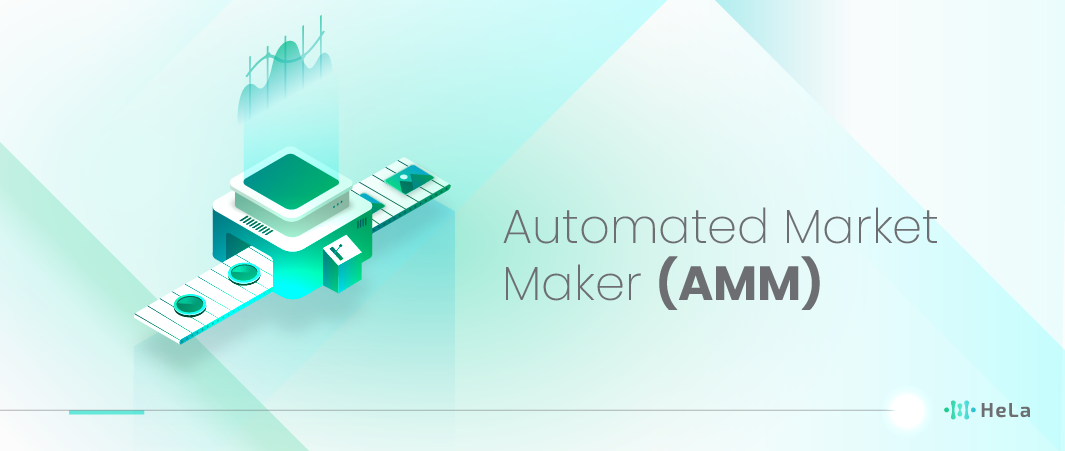The financial world is constantly evolving, and at the heart of this transformation is the concept of Automated Market Makers (AMM). This revolutionary system has altered the way we trade and invest, making it crucial for anyone in the finance field to understand its mechanics and implications. In this guide, we will journey through the essentials of AMMs, exploring their purpose, functionality, and the significant role they play in the decentralized finance (DeFi) space.
An Automated Market Maker is a type of decentralized exchange protocol that relies on a mathematical formula to price assets. Unlike traditional market systems, which need buyers and sellers to determine the price of an asset, AMMs use a predefined pricing algorithm. This fundamental shift from traditional market-making mechanisms introduces a new era of trading, where liquidity is provided by pools instead of market players, ensuring constant buy and sell prices.
Understanding AMMs is not just about grasping a new financial tool; it’s about recognizing a shift in how liquidity is provided and how assets are traded. With the rise of blockchain technology and the increasing adoption of DeFi, AMMs are becoming more significant. This guide aims to provide a thorough understanding, breaking down complex terms and processes into simple, digestible information.
What Is Automated Market Makers and Its Mechanics
Automated Market Makers redefine the landscape of trading and finance. At their essence, AMMs are decentralized protocols that enable digital assets to be traded automatically and without the need for traditional market makers. By using liquidity pools instead of order books, AMMs facilitate trading by ensuring there is always a counterparty ready to fill a trade. This not only streamlines the trading process but also enhances liquidity, making markets more efficient and accessible.
Automated Market Makers operate on a unique principle that sets them apart from traditional market models. At the core of any AMM is the liquidity pool, a digital pile of funds locked in a smart contract. Users, known as liquidity providers, add their funds to these pools and, in return, receive liquidity tokens. These tokens can later be redeemed for a share of the pool, plus a portion of the trading fees.
Also Read: Top 7 Meme Coins To Consider in 2024
The pricing of assets in these pools is determined by a mathematical formula, the most common one being the constant product formula, x∗y=k, where x and y represent the quantity of the two tokens in the liquidity pool, and k is a constant. This formula ensures that the product of the quantities remains constant, hence maintaining the pool’s overall balance.
The Benefits of Using AMMs
Automated Market Makers (AMMs) present a paradigm shift in how assets are exchanged by leveraging algorithmic trading mechanisms to facilitate liquidity in financial markets, particularly within the decentralized finance (DeFi) space. Beyond offering continuous liquidity and a permissionless environment, there are additional layers of benefits that AMMs provide when compared to their traditional market counterparts.
Reduced Dependency on Market Makers
Traditional markets often rely on intermediaries or market makers to ensure liquidity, who may demand a premium for their services. AMMs, on the other hand, utilize mathematical formulas to determine the price of assets and execute trades, which can reduce trading costs and the spread between buy and sell prices.
Price Discovery Mechanism
AMMs contribute to more efficient price discovery. In traditional systems, assets may be illiquid or not frequently traded, leading to outdated or inaccurate pricing. AMMs continuously adjust prices based on supply and demand dynamics through their algorithmic design, offering more current and fair market prices.
Transparency and Security
The operations within AMMs are executed on blockchain technology, ensuring a high level of transparency and security. Every transaction is recorded on the blockchain, providing an immutable and verifiable record of all trades and liquidity provision. This transparency mitigates the risk of fraudulent activities and market manipulation, prevalent concerns in traditional financial systems.
Reduced Entry Barriers for New Assets
In traditional systems, listing a new asset can be a cumbersome and regulatory-intensive process. AMMs lower these barriers, allowing for the swift integration of new tokens or assets into the market. This fosters innovation and allows projects to gain liquidity without the need for intermediaries or substantial capital.
Enhanced Capital Efficiency
Some AMM models incorporate mechanisms for optimizing capital allocation, such as concentrated liquidity. This allows liquidity providers to allocate their funds within specific price ranges, maximizing their capital efficiency and potential returns on investment.
While AMMs revolutionize asset exchange and liquidity provision, it’s also important to note the associated risks and complexities, such as impermanent loss for liquidity providers and the technical and operational understanding required to interact with these systems securely. As the DeFi space continues to evolve, it’s likely that AMMs will undergo further innovations, addressing current limitations and enhancing their benefits in the ever-changing landscape of finance.
Risks and Considerations in AMM Systems

Automated Market Makers (AMMs) are pivotal components of the decentralized finance (DeFi) ecosystem, facilitating trading by providing liquidity in a permissionless and automated manner. They operate by relying on mathematical formulas to price assets, rather than traditional order books used in conventional markets. However, while AMMs democratize market access and can offer greater liquidity and trading opportunities, they are not without their challenges and risks. Here are some detailed considerations:
Impermanent Loss
One of the primary risks in AMM systems is impermanent loss. This occurs when the price of the assets in a liquidity pool diverges in any direction from the price at the time they were deposited. The term ‘impermanent’ suggests that the loss could be temporary if the prices were to revert to their original state. However, if a liquidity provider decides to withdraw their assets from the pool while the prices are misaligned, the loss becomes permanent. This risk is intrinsic to the AMM model and is more pronounced in pools with highly volatile assets.
Smart Contract Vulnerabilities
AMMs are fundamentally reliant on smart contracts – self-executing contracts with the terms directly written into code. While smart contracts automate and enforce agreements trustlessly, they are also prone to bugs and vulnerabilities. If a smart contract has a flaw or security loophole, it can be exploited, leading to the loss of funds. The immutable nature of blockchain means that any such exploit can be irreversible, leading to permanent loss of user funds
Regulatory Uncertainty
The DeFi space, and by extension AMMs, operate in a relatively new and rapidly evolving sector where regulatory frameworks can be unclear or non-existent. This lack of clarity can pose risks related to compliance with existing financial laws and future regulatory actions, potentially affecting the operation and accessibility of AMM platforms.
Front-running and Slippage
In AMM platforms, transactions are transparent and broadcasted to the network before being confirmed. This transparency can be exploited through ‘front-running,’ where an individual sees a pending transaction and pays a higher gas fee to get their transaction included in the blockchain first. Additionally, ‘slippage’ refers to the difference between the expected price of a trade and the executed price. In highly volatile markets or pools with low liquidity, slippage can be significant, leading to unfavorable execution prices.
Liquidity Provider (LP) Dilution
New liquidity providers can dilute existing providers’ share of the pool. As more liquidity is added, the share of the pool of each provider decreases, potentially reducing the profit each LP derives from fees.
While AMMs revolutionize trading and liquidity provision, understanding and mitigating these risks is crucial for participants in the DeFi space. Users and liquidity providers must perform due diligence, understand the mechanisms of AMM platforms they use, and consider strategies to minimize risks, such as diversifying their investment and staying informed about the latest developments in smart contract security and regulatory changes.
The Role of AMMs in Decentralized Finance (DeFi)

Automated Market Makers (AMMs) are a pivotal component of the Decentralized Finance (DeFi) ecosystem. They are instrumental in reshaping the landscape of the financial sector by offering an alternative to traditional market structures. Unlike conventional financial markets that rely on order books and market makers to facilitate trading, AMMs utilize algorithms and smart contracts to enable asset trading. This is achieved by maintaining liquidity pools—reservoirs of tokens that users can trade against.
In the DeFi space, AMMs play a crucial role by providing the infrastructure necessary for various financial activities, such as trading, lending, and borrowing, in a decentralized manner. This is significant as it removes the need for traditional financial intermediaries like banks, brokers, and exchanges, thereby reducing costs, enhancing transaction speed, and increasing accessibility. Users can interact directly with smart contracts to execute their transactions, ensuring transparency and reducing the chances of manipulation or censorship.
One of the remarkable features of AMMs is their contribution to liquidity in the DeFi market. In traditional finance, liquidity is often provided by large financial institutions or market makers. However, in the DeFi ecosystem, liquidity is crowd-sourced from individual users who deposit their assets into the liquidity pools. In return, these liquidity providers earn fees based on the trading activity in the pool, which is governed by the AMM’s specific protocol.
Moreover, AMMs are not just isolated mechanisms; they are deeply integrated with other DeFi protocols. This integration amplifies the capabilities of the DeFi ecosystem, leading to the creation of complex and innovative financial products and services. For instance, yield farming and staking are concepts that have emerged from the symbiotic relationship between AMMs and other DeFi protocols, offering users new ways to earn returns on their crypto assets.
However, while AMMs are a groundbreaking innovation in the financial sector, they are not without challenges. Issues such as impermanent loss, price slippage, and smart contract vulnerabilities are some of the risks associated with AMMs. Despite these challenges, the potential of AMMs to democratize finance, enhance financial inclusion, and foster the development of an open, transparent, and efficient financial system is immense.
AMMs are more than just a component of the DeFi ecosystem; they are a transformative force in the financial sector. By enabling decentralized trading, lending, and borrowing, and by integrating with other DeFi protocols, AMMs are paving the way for a new financial paradigm. As the DeFi space continues to evolve, it is expected that AMMs will play an even more significant role in shaping the future of finance.
Future Outlook and Developments in AMM Technology

The future outlook for Automated Market Makers (AMMs) is highly optimistic, driven by a wave of technological advancements and strategic improvements in their operational frameworks. As we look ahead, several key developments are poised to revolutionize the AMM landscape:
- Advancements in Smart Contract Technology: Smart contracts are at the heart of AMMs, automating asset trading without the need for traditional intermediaries. The future will likely see more robust, flexible, and secure smart contracts. This evolution will enhance the trustworthiness and resilience of AMMs, mitigating risks like smart contract vulnerabilities which have been a concern in the past.
- Sophisticated Liquidity Pool Strategies: Liquidity pools are crucial for AMMs, enabling trading by holding reserves of multiple tokens. Innovations in liquidity pool designs are anticipated, aiming to optimize the capital efficiency and minimize the risks for liquidity providers. This might include dynamic adjustment of fees based on market conditions, or the implementation of concentrated liquidity, allowing liquidity providers to allocate capital within specific price ranges.
- Integration of Advanced Algorithms: The efficiency of AMMs can be significantly impacted by the pricing algorithms they use. Future developments are expected to introduce more sophisticated algorithms, potentially borrowing from traditional finance or novel, blockchain-native concepts. These algorithms will aim to provide more accurate pricing, reduced slippage, and improved overall market stability.
- Enhanced User Experience: As the DeFi sector matures, a significant emphasis will be placed on making AMMs more accessible and user-friendly. This could involve more intuitive user interfaces, better integration with various wallets and platforms, and improved transaction speed and cost-effectiveness.
- Regulatory Clarity and Compliance: As AMMs become more prevalent, regulatory frameworks are expected to evolve to provide clear guidelines and security for users. This will likely lead to more compliant and standardized practices within the AMM space, potentially opening up these platforms to a broader user base.
Also Read: 10 Polkadot Killers to Consider in 2024
- Cross-chain and Multi-layer Solutions: To address issues of scalability and interoperability, future AMM solutions may incorporate cross-chain and multi-layer functionalities. This would allow seamless asset transfers and interactions across different blockchain networks, vastly expanding the potential use cases and user base for AMMs.
- Integration with Traditional Finance: As the gap between decentralized and traditional finance narrows, AMMs might see integration with conventional financial instruments and markets. This could lead to a new era of financial products that combine the best of both worlds, offering the security and structure of traditional finance with the transparency and efficiency of DeFi.
The future of AMMs is not just about incremental improvements but also about foundational shifts in how financial services can be structured and delivered. With their inherent advantages in terms of transparency, security, and inclusivity, AMMs are well-positioned to be a cornerstone of the evolving financial landscape. As these technologies and strategies mature, we can expect AMMs to offer more sophisticated, efficient, and user-centric financial services, playing a pivotal role in the broader adoption of DeFi solutions.
Conclusion
Automated Market Makers represent a paradigm shift in the world of finance. By simplifying the exchange process and making it more accessible, AMMs are not just a component of the DeFi ecosystem; they are at its very core. They democratize finance, empower individuals, and pave the way for a more inclusive financial system.
However, like any financial tool, they come with their own set of risks and challenges. Understanding these, staying informed about the latest developments, and approaching with caution are crucial for anyone looking to navigate this space successfully.
As we stand on the brink of a new financial era, the role of AMMs cannot be overstated. They are more than just a technological innovation; they are a testament to the potential of decentralized systems and the promise they hold for a more equitable financial future. Embracing AMMs and the broader DeFi space requires a willingness to learn, adapt, and innovate, but the rewards can be significant for those who are ready to take on the challenge.
Disclaimer: The information provided by HeLa Labs in this article is intended for general informational purposes and does not reflect the company’s opinion. It is not intended as investment advice or recommendations. Readers are strongly advised to conduct their own through research and consult with a qualified financial advisor before making any financial decisions.

Joshua Soriano
I am a writer specializing in decentralized systems, digital assets, and Web3 innovation. I develop research-driven explainers, case studies, and thought leadership that connect blockchain infrastructure, smart contract design, and tokenization models to real-world outcomes.
My work focuses on translating complex technical concepts into clear, actionable narratives for builders, businesses, and investors, highlighting transparency, security, and operational efficiency. Each piece blends primary-source research, protocol documentation, and practitioner insights to surface what matters for adoption and risk reduction, helping teams make informed decisions with precise, accessible content.
- Joshua Soriano#molongui-disabled-link
- Joshua Soriano#molongui-disabled-link
- Joshua Soriano#molongui-disabled-link
- Joshua Soriano#molongui-disabled-link

